Impact of Democratic Leadership on Employee Motivation and Productivity in B&Q
VerifiedAdded on 2019/12/03
|13
|3776
|155
Essay
AI Summary
The provided content discusses the concept of organizational behavior and its application in a workplace, specifically at B&Q. It highlights the importance of understanding employee attitudes and behaviors to achieve organizational objectives. The content also explores various approaches to leadership and motivation, including understanding employee needs, building trust, and fostering a positive work environment. Finally, it concludes that effective management is crucial for achieving success and notes that there are different ways to manage employees, such as through collective and network approaches.
Contribute Materials
Your contribution can guide someone’s learning journey. Share your
documents today.
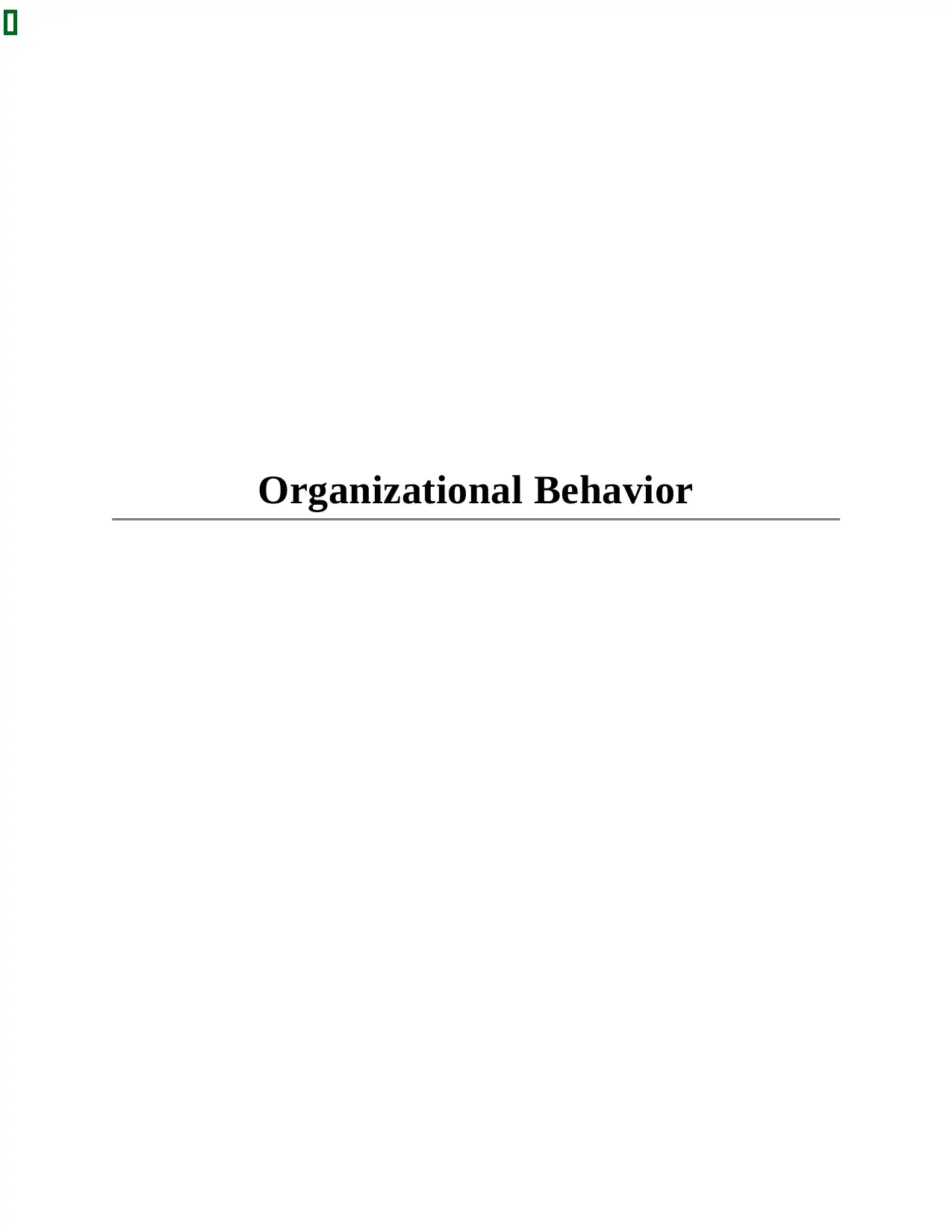
Organizational Behavior
Secure Best Marks with AI Grader
Need help grading? Try our AI Grader for instant feedback on your assignments.
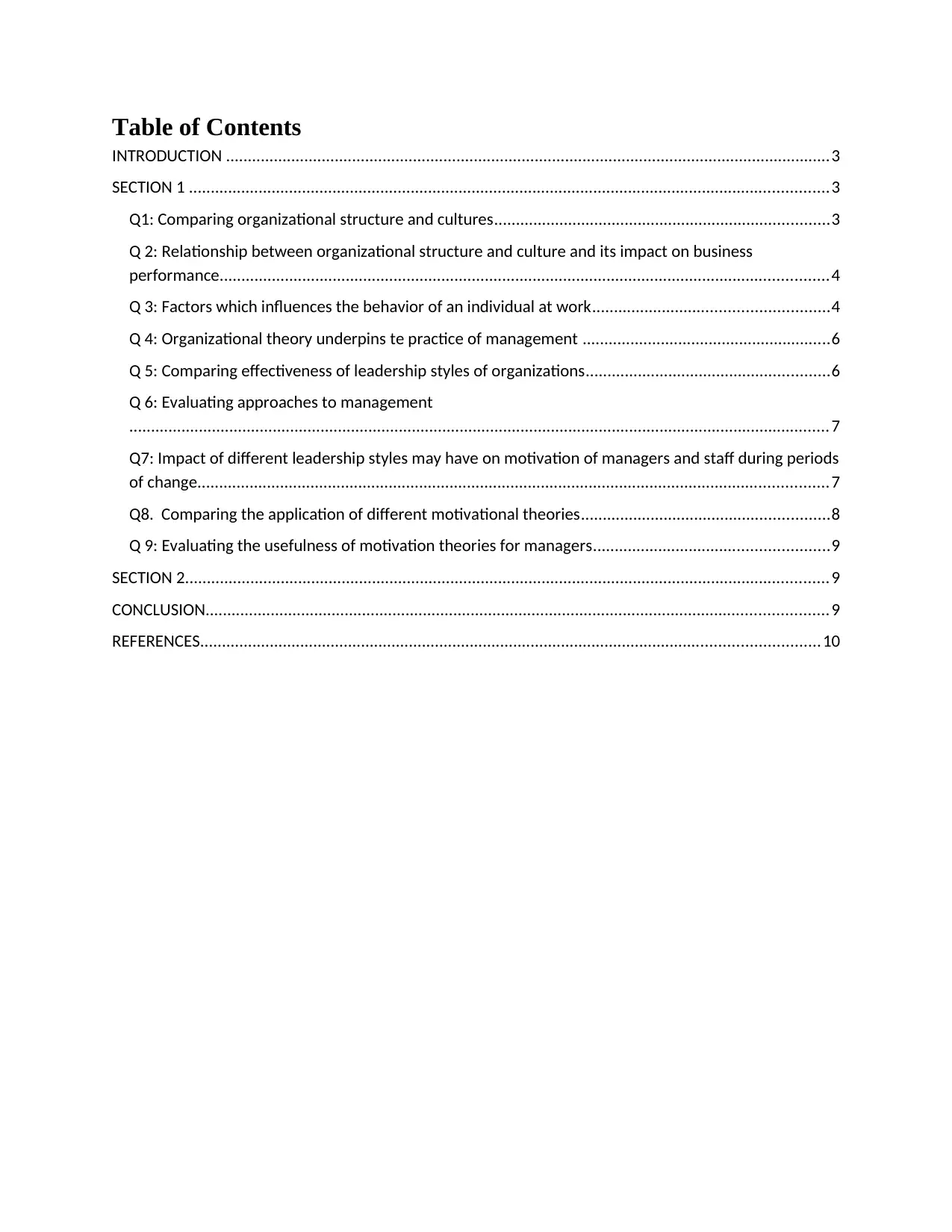
Table of Contents
INTRODUCTION ...........................................................................................................................................3
SECTION 1 ...................................................................................................................................................3
Q1: Comparing organizational structure and cultures.............................................................................3
Q 2: Relationship between organizational structure and culture and its impact on business
performance............................................................................................................................................4
Q 3: Factors which influences the behavior of an individual at work......................................................4
Q 4: Organizational theory underpins te practice of management .........................................................6
Q 5: Comparing effectiveness of leadership styles of organizations........................................................6
Q 6: Evaluating approaches to management
.................................................................................................................................................................7
Q7: Impact of different leadership styles may have on motivation of managers and staff during periods
of change.................................................................................................................................................7
Q8. Comparing the application of different motivational theories.........................................................8
Q 9: Evaluating the usefulness of motivation theories for managers......................................................9
SECTION 2....................................................................................................................................................9
CONCLUSION...............................................................................................................................................9
REFERENCES..............................................................................................................................................10
INTRODUCTION ...........................................................................................................................................3
SECTION 1 ...................................................................................................................................................3
Q1: Comparing organizational structure and cultures.............................................................................3
Q 2: Relationship between organizational structure and culture and its impact on business
performance............................................................................................................................................4
Q 3: Factors which influences the behavior of an individual at work......................................................4
Q 4: Organizational theory underpins te practice of management .........................................................6
Q 5: Comparing effectiveness of leadership styles of organizations........................................................6
Q 6: Evaluating approaches to management
.................................................................................................................................................................7
Q7: Impact of different leadership styles may have on motivation of managers and staff during periods
of change.................................................................................................................................................7
Q8. Comparing the application of different motivational theories.........................................................8
Q 9: Evaluating the usefulness of motivation theories for managers......................................................9
SECTION 2....................................................................................................................................................9
CONCLUSION...............................................................................................................................................9
REFERENCES..............................................................................................................................................10
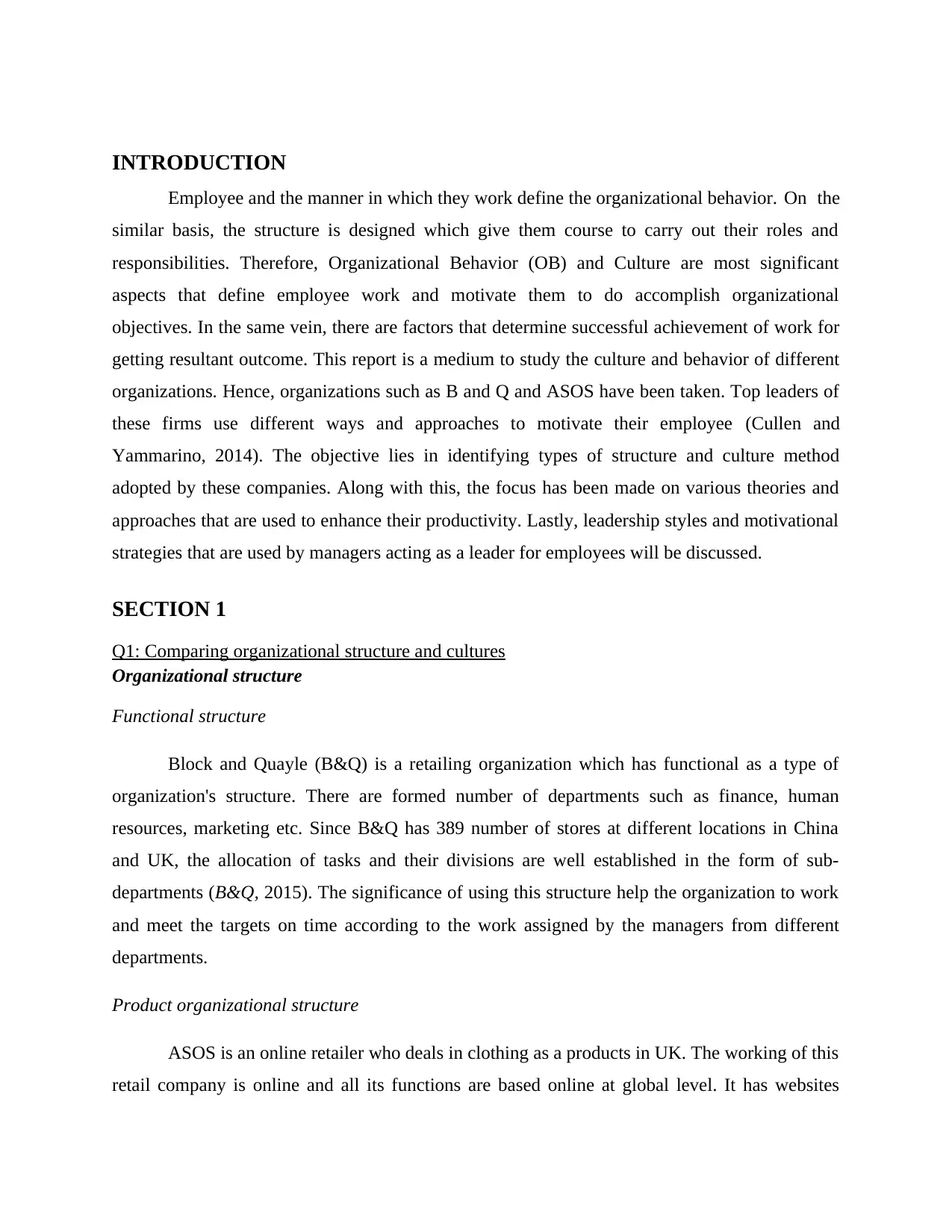
INTRODUCTION
Employee and the manner in which they work define the organizational behavior. On the
similar basis, the structure is designed which give them course to carry out their roles and
responsibilities. Therefore, Organizational Behavior (OB) and Culture are most significant
aspects that define employee work and motivate them to do accomplish organizational
objectives. In the same vein, there are factors that determine successful achievement of work for
getting resultant outcome. This report is a medium to study the culture and behavior of different
organizations. Hence, organizations such as B and Q and ASOS have been taken. Top leaders of
these firms use different ways and approaches to motivate their employee (Cullen and
Yammarino, 2014). The objective lies in identifying types of structure and culture method
adopted by these companies. Along with this, the focus has been made on various theories and
approaches that are used to enhance their productivity. Lastly, leadership styles and motivational
strategies that are used by managers acting as a leader for employees will be discussed.
SECTION 1
Q1: Comparing organizational structure and cultures
Organizational structure
Functional structure
Block and Quayle (B&Q) is a retailing organization which has functional as a type of
organization's structure. There are formed number of departments such as finance, human
resources, marketing etc. Since B&Q has 389 number of stores at different locations in China
and UK, the allocation of tasks and their divisions are well established in the form of sub-
departments (B&Q, 2015). The significance of using this structure help the organization to work
and meet the targets on time according to the work assigned by the managers from different
departments.
Product organizational structure
ASOS is an online retailer who deals in clothing as a products in UK. The working of this
retail company is online and all its functions are based online at global level. It has websites
Employee and the manner in which they work define the organizational behavior. On the
similar basis, the structure is designed which give them course to carry out their roles and
responsibilities. Therefore, Organizational Behavior (OB) and Culture are most significant
aspects that define employee work and motivate them to do accomplish organizational
objectives. In the same vein, there are factors that determine successful achievement of work for
getting resultant outcome. This report is a medium to study the culture and behavior of different
organizations. Hence, organizations such as B and Q and ASOS have been taken. Top leaders of
these firms use different ways and approaches to motivate their employee (Cullen and
Yammarino, 2014). The objective lies in identifying types of structure and culture method
adopted by these companies. Along with this, the focus has been made on various theories and
approaches that are used to enhance their productivity. Lastly, leadership styles and motivational
strategies that are used by managers acting as a leader for employees will be discussed.
SECTION 1
Q1: Comparing organizational structure and cultures
Organizational structure
Functional structure
Block and Quayle (B&Q) is a retailing organization which has functional as a type of
organization's structure. There are formed number of departments such as finance, human
resources, marketing etc. Since B&Q has 389 number of stores at different locations in China
and UK, the allocation of tasks and their divisions are well established in the form of sub-
departments (B&Q, 2015). The significance of using this structure help the organization to work
and meet the targets on time according to the work assigned by the managers from different
departments.
Product organizational structure
ASOS is an online retailer who deals in clothing as a products in UK. The working of this
retail company is online and all its functions are based online at global level. It has websites
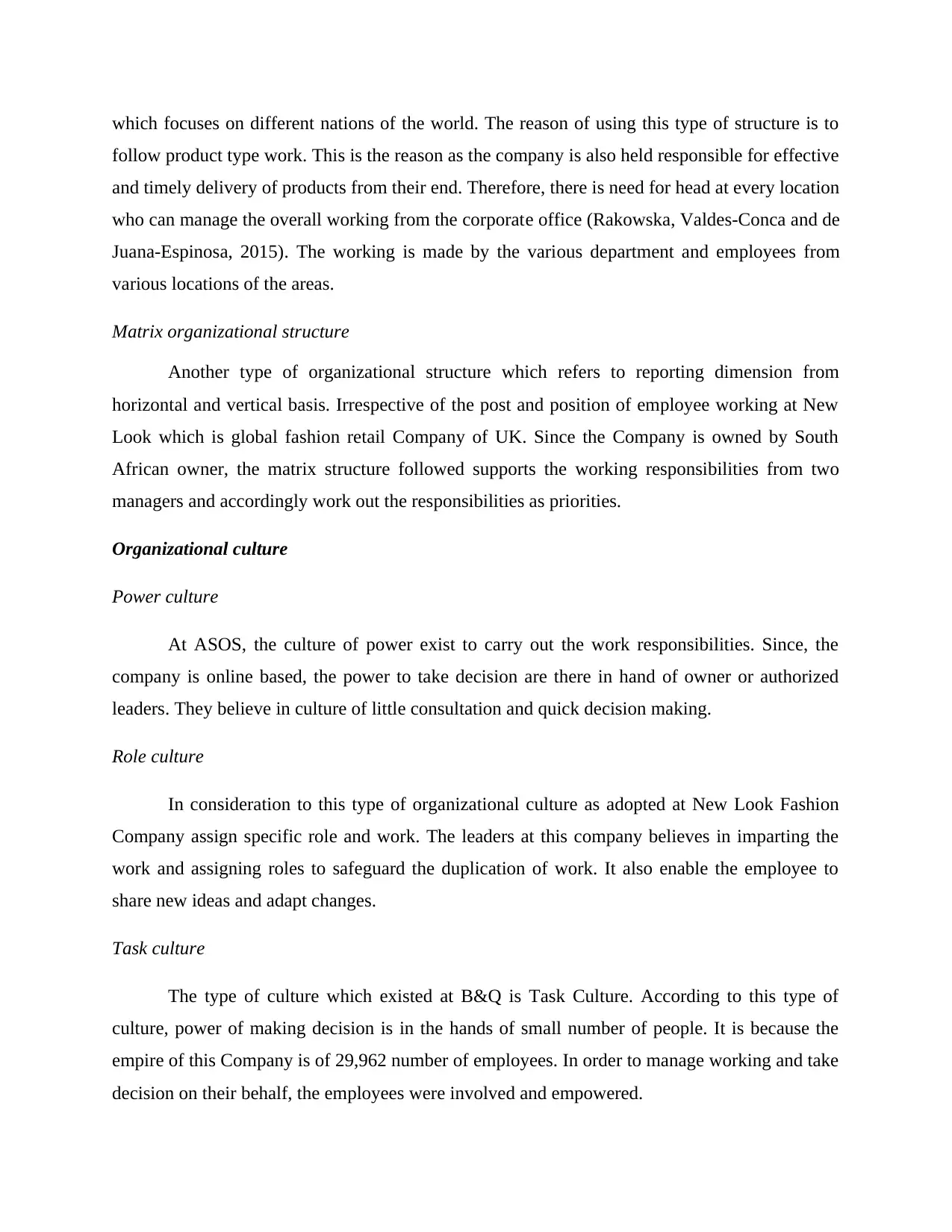
which focuses on different nations of the world. The reason of using this type of structure is to
follow product type work. This is the reason as the company is also held responsible for effective
and timely delivery of products from their end. Therefore, there is need for head at every location
who can manage the overall working from the corporate office (Rakowska, Valdes-Conca and de
Juana-Espinosa, 2015). The working is made by the various department and employees from
various locations of the areas.
Matrix organizational structure
Another type of organizational structure which refers to reporting dimension from
horizontal and vertical basis. Irrespective of the post and position of employee working at New
Look which is global fashion retail Company of UK. Since the Company is owned by South
African owner, the matrix structure followed supports the working responsibilities from two
managers and accordingly work out the responsibilities as priorities.
Organizational culture
Power culture
At ASOS, the culture of power exist to carry out the work responsibilities. Since, the
company is online based, the power to take decision are there in hand of owner or authorized
leaders. They believe in culture of little consultation and quick decision making.
Role culture
In consideration to this type of organizational culture as adopted at New Look Fashion
Company assign specific role and work. The leaders at this company believes in imparting the
work and assigning roles to safeguard the duplication of work. It also enable the employee to
share new ideas and adapt changes.
Task culture
The type of culture which existed at B&Q is Task Culture. According to this type of
culture, power of making decision is in the hands of small number of people. It is because the
empire of this Company is of 29,962 number of employees. In order to manage working and take
decision on their behalf, the employees were involved and empowered.
follow product type work. This is the reason as the company is also held responsible for effective
and timely delivery of products from their end. Therefore, there is need for head at every location
who can manage the overall working from the corporate office (Rakowska, Valdes-Conca and de
Juana-Espinosa, 2015). The working is made by the various department and employees from
various locations of the areas.
Matrix organizational structure
Another type of organizational structure which refers to reporting dimension from
horizontal and vertical basis. Irrespective of the post and position of employee working at New
Look which is global fashion retail Company of UK. Since the Company is owned by South
African owner, the matrix structure followed supports the working responsibilities from two
managers and accordingly work out the responsibilities as priorities.
Organizational culture
Power culture
At ASOS, the culture of power exist to carry out the work responsibilities. Since, the
company is online based, the power to take decision are there in hand of owner or authorized
leaders. They believe in culture of little consultation and quick decision making.
Role culture
In consideration to this type of organizational culture as adopted at New Look Fashion
Company assign specific role and work. The leaders at this company believes in imparting the
work and assigning roles to safeguard the duplication of work. It also enable the employee to
share new ideas and adapt changes.
Task culture
The type of culture which existed at B&Q is Task Culture. According to this type of
culture, power of making decision is in the hands of small number of people. It is because the
empire of this Company is of 29,962 number of employees. In order to manage working and take
decision on their behalf, the employees were involved and empowered.
Secure Best Marks with AI Grader
Need help grading? Try our AI Grader for instant feedback on your assignments.
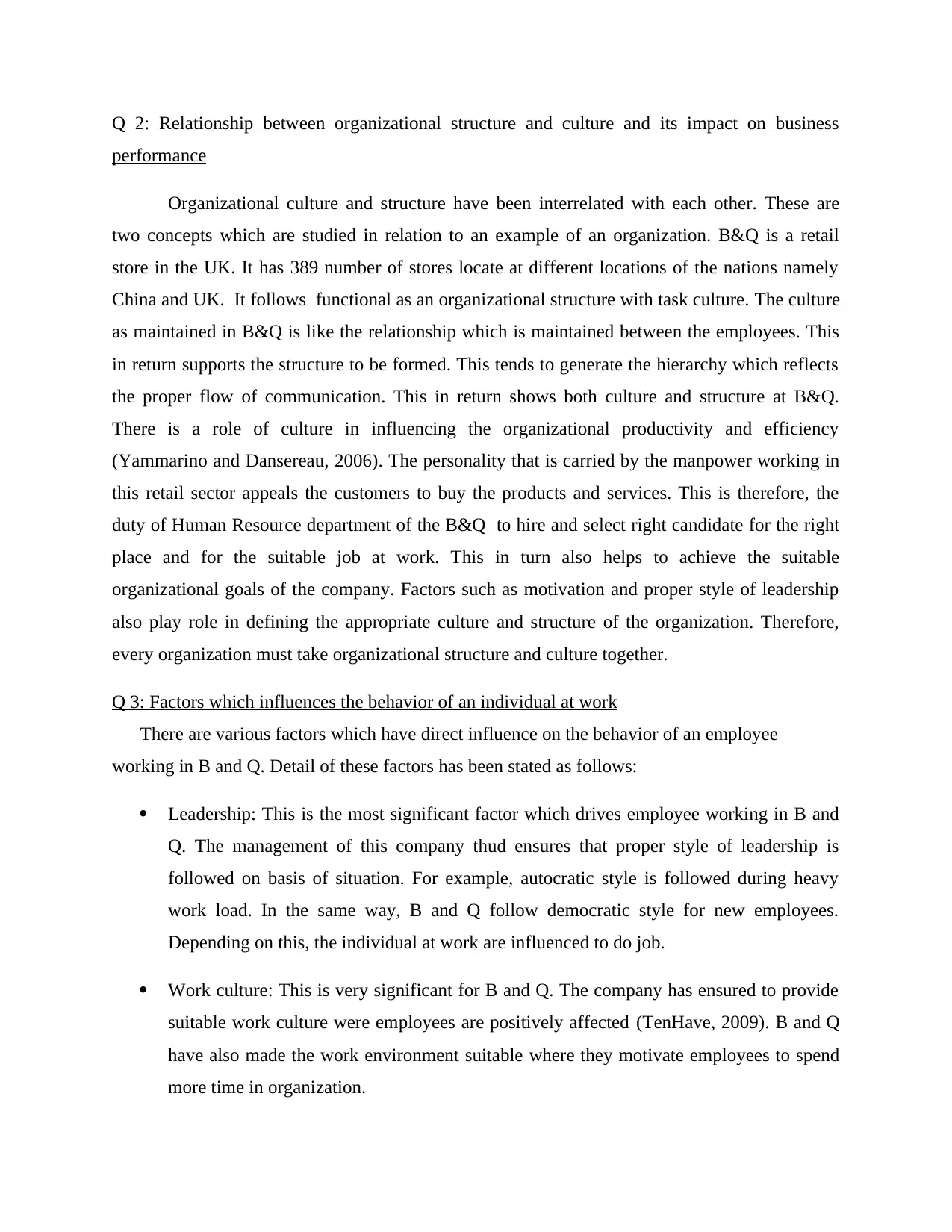
Q 2: Relationship between organizational structure and culture and its impact on business
performance
Organizational culture and structure have been interrelated with each other. These are
two concepts which are studied in relation to an example of an organization. B&Q is a retail
store in the UK. It has 389 number of stores locate at different locations of the nations namely
China and UK. It follows functional as an organizational structure with task culture. The culture
as maintained in B&Q is like the relationship which is maintained between the employees. This
in return supports the structure to be formed. This tends to generate the hierarchy which reflects
the proper flow of communication. This in return shows both culture and structure at B&Q.
There is a role of culture in influencing the organizational productivity and efficiency
(Yammarino and Dansereau, 2006). The personality that is carried by the manpower working in
this retail sector appeals the customers to buy the products and services. This is therefore, the
duty of Human Resource department of the B&Q to hire and select right candidate for the right
place and for the suitable job at work. This in turn also helps to achieve the suitable
organizational goals of the company. Factors such as motivation and proper style of leadership
also play role in defining the appropriate culture and structure of the organization. Therefore,
every organization must take organizational structure and culture together.
Q 3: Factors which influences the behavior of an individual at work
There are various factors which have direct influence on the behavior of an employee
working in B and Q. Detail of these factors has been stated as follows:
Leadership: This is the most significant factor which drives employee working in B and
Q. The management of this company thud ensures that proper style of leadership is
followed on basis of situation. For example, autocratic style is followed during heavy
work load. In the same way, B and Q follow democratic style for new employees.
Depending on this, the individual at work are influenced to do job.
Work culture: This is very significant for B and Q. The company has ensured to provide
suitable work culture were employees are positively affected (TenHave, 2009). B and Q
have also made the work environment suitable where they motivate employees to spend
more time in organization.
performance
Organizational culture and structure have been interrelated with each other. These are
two concepts which are studied in relation to an example of an organization. B&Q is a retail
store in the UK. It has 389 number of stores locate at different locations of the nations namely
China and UK. It follows functional as an organizational structure with task culture. The culture
as maintained in B&Q is like the relationship which is maintained between the employees. This
in return supports the structure to be formed. This tends to generate the hierarchy which reflects
the proper flow of communication. This in return shows both culture and structure at B&Q.
There is a role of culture in influencing the organizational productivity and efficiency
(Yammarino and Dansereau, 2006). The personality that is carried by the manpower working in
this retail sector appeals the customers to buy the products and services. This is therefore, the
duty of Human Resource department of the B&Q to hire and select right candidate for the right
place and for the suitable job at work. This in turn also helps to achieve the suitable
organizational goals of the company. Factors such as motivation and proper style of leadership
also play role in defining the appropriate culture and structure of the organization. Therefore,
every organization must take organizational structure and culture together.
Q 3: Factors which influences the behavior of an individual at work
There are various factors which have direct influence on the behavior of an employee
working in B and Q. Detail of these factors has been stated as follows:
Leadership: This is the most significant factor which drives employee working in B and
Q. The management of this company thud ensures that proper style of leadership is
followed on basis of situation. For example, autocratic style is followed during heavy
work load. In the same way, B and Q follow democratic style for new employees.
Depending on this, the individual at work are influenced to do job.
Work culture: This is very significant for B and Q. The company has ensured to provide
suitable work culture were employees are positively affected (TenHave, 2009). B and Q
have also made the work environment suitable where they motivate employees to spend
more time in organization.
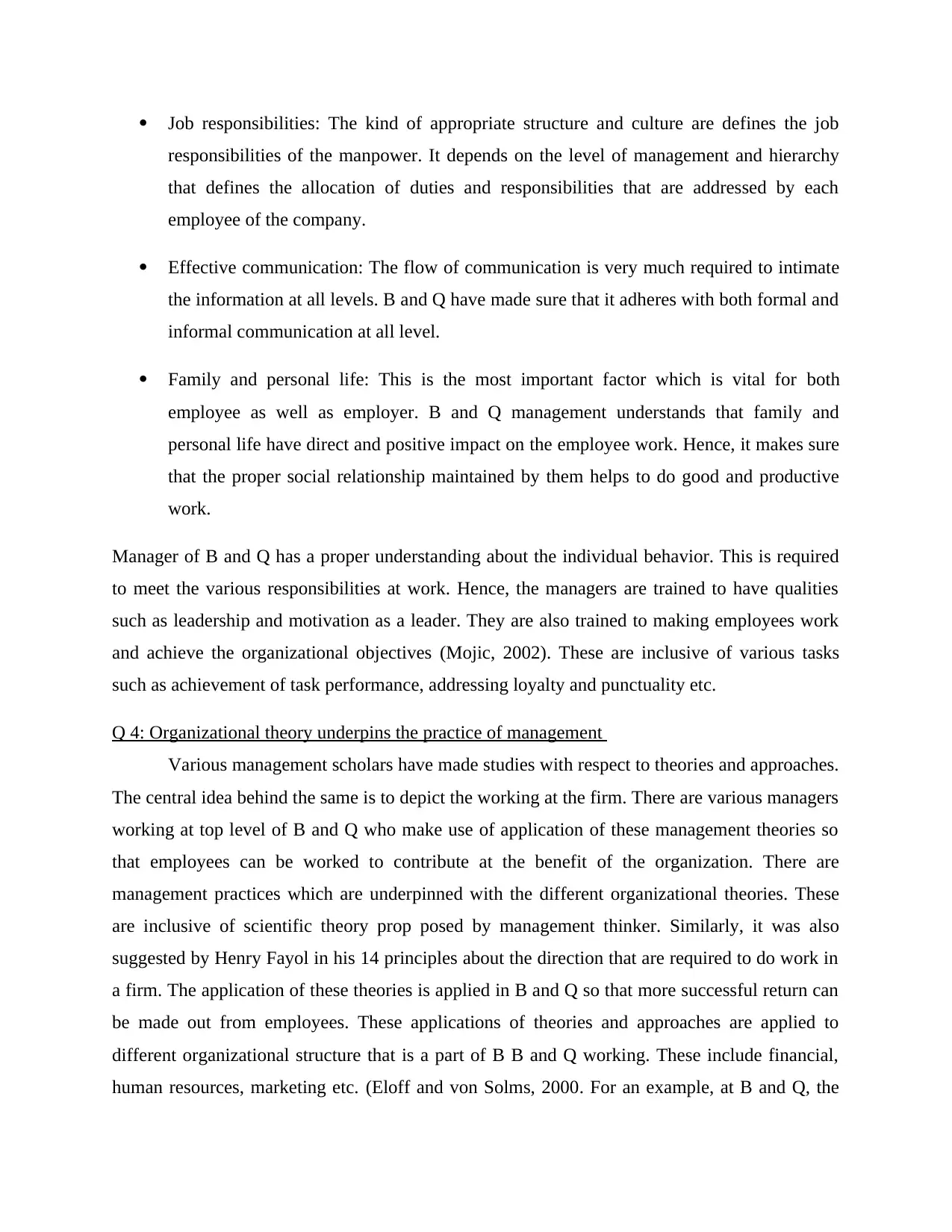
Job responsibilities: The kind of appropriate structure and culture are defines the job
responsibilities of the manpower. It depends on the level of management and hierarchy
that defines the allocation of duties and responsibilities that are addressed by each
employee of the company.
Effective communication: The flow of communication is very much required to intimate
the information at all levels. B and Q have made sure that it adheres with both formal and
informal communication at all level.
Family and personal life: This is the most important factor which is vital for both
employee as well as employer. B and Q management understands that family and
personal life have direct and positive impact on the employee work. Hence, it makes sure
that the proper social relationship maintained by them helps to do good and productive
work.
Manager of B and Q has a proper understanding about the individual behavior. This is required
to meet the various responsibilities at work. Hence, the managers are trained to have qualities
such as leadership and motivation as a leader. They are also trained to making employees work
and achieve the organizational objectives (Mojic, 2002). These are inclusive of various tasks
such as achievement of task performance, addressing loyalty and punctuality etc.
Q 4: Organizational theory underpins the practice of management
Various management scholars have made studies with respect to theories and approaches.
The central idea behind the same is to depict the working at the firm. There are various managers
working at top level of B and Q who make use of application of these management theories so
that employees can be worked to contribute at the benefit of the organization. There are
management practices which are underpinned with the different organizational theories. These
are inclusive of scientific theory prop posed by management thinker. Similarly, it was also
suggested by Henry Fayol in his 14 principles about the direction that are required to do work in
a firm. The application of these theories is applied in B and Q so that more successful return can
be made out from employees. These applications of theories and approaches are applied to
different organizational structure that is a part of B B and Q working. These include financial,
human resources, marketing etc. (Eloff and von Solms, 2000. For an example, at B and Q, the
responsibilities of the manpower. It depends on the level of management and hierarchy
that defines the allocation of duties and responsibilities that are addressed by each
employee of the company.
Effective communication: The flow of communication is very much required to intimate
the information at all levels. B and Q have made sure that it adheres with both formal and
informal communication at all level.
Family and personal life: This is the most important factor which is vital for both
employee as well as employer. B and Q management understands that family and
personal life have direct and positive impact on the employee work. Hence, it makes sure
that the proper social relationship maintained by them helps to do good and productive
work.
Manager of B and Q has a proper understanding about the individual behavior. This is required
to meet the various responsibilities at work. Hence, the managers are trained to have qualities
such as leadership and motivation as a leader. They are also trained to making employees work
and achieve the organizational objectives (Mojic, 2002). These are inclusive of various tasks
such as achievement of task performance, addressing loyalty and punctuality etc.
Q 4: Organizational theory underpins the practice of management
Various management scholars have made studies with respect to theories and approaches.
The central idea behind the same is to depict the working at the firm. There are various managers
working at top level of B and Q who make use of application of these management theories so
that employees can be worked to contribute at the benefit of the organization. There are
management practices which are underpinned with the different organizational theories. These
are inclusive of scientific theory prop posed by management thinker. Similarly, it was also
suggested by Henry Fayol in his 14 principles about the direction that are required to do work in
a firm. The application of these theories is applied in B and Q so that more successful return can
be made out from employees. These applications of theories and approaches are applied to
different organizational structure that is a part of B B and Q working. These include financial,
human resources, marketing etc. (Eloff and von Solms, 2000. For an example, at B and Q, the
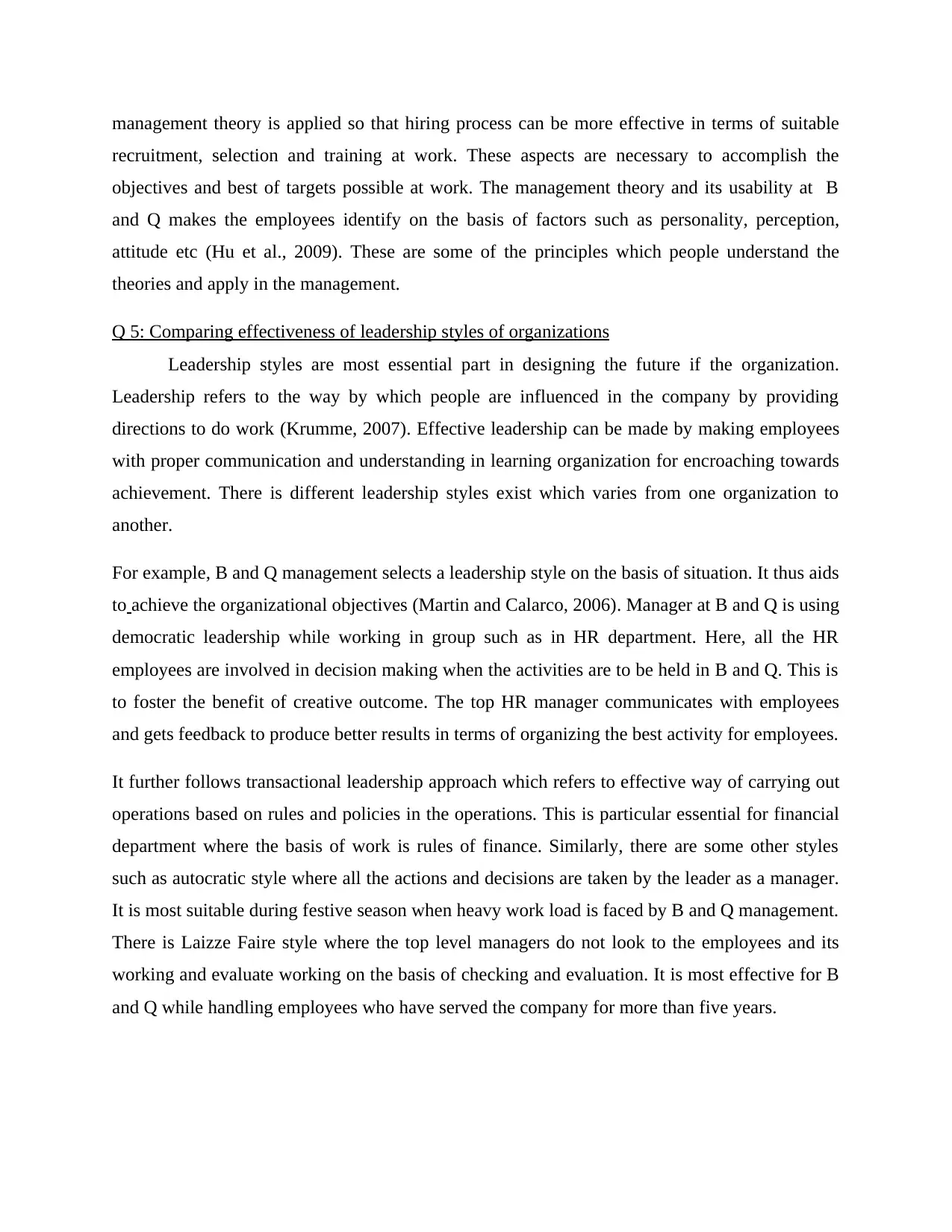
management theory is applied so that hiring process can be more effective in terms of suitable
recruitment, selection and training at work. These aspects are necessary to accomplish the
objectives and best of targets possible at work. The management theory and its usability at B
and Q makes the employees identify on the basis of factors such as personality, perception,
attitude etc (Hu et al., 2009). These are some of the principles which people understand the
theories and apply in the management.
Q 5: Comparing effectiveness of leadership styles of organizations
Leadership styles are most essential part in designing the future if the organization.
Leadership refers to the way by which people are influenced in the company by providing
directions to do work (Krumme, 2007). Effective leadership can be made by making employees
with proper communication and understanding in learning organization for encroaching towards
achievement. There is different leadership styles exist which varies from one organization to
another.
For example, B and Q management selects a leadership style on the basis of situation. It thus aids
to achieve the organizational objectives (Martin and Calarco, 2006). Manager at B and Q is using
democratic leadership while working in group such as in HR department. Here, all the HR
employees are involved in decision making when the activities are to be held in B and Q. This is
to foster the benefit of creative outcome. The top HR manager communicates with employees
and gets feedback to produce better results in terms of organizing the best activity for employees.
It further follows transactional leadership approach which refers to effective way of carrying out
operations based on rules and policies in the operations. This is particular essential for financial
department where the basis of work is rules of finance. Similarly, there are some other styles
such as autocratic style where all the actions and decisions are taken by the leader as a manager.
It is most suitable during festive season when heavy work load is faced by B and Q management.
There is Laizze Faire style where the top level managers do not look to the employees and its
working and evaluate working on the basis of checking and evaluation. It is most effective for B
and Q while handling employees who have served the company for more than five years.
recruitment, selection and training at work. These aspects are necessary to accomplish the
objectives and best of targets possible at work. The management theory and its usability at B
and Q makes the employees identify on the basis of factors such as personality, perception,
attitude etc (Hu et al., 2009). These are some of the principles which people understand the
theories and apply in the management.
Q 5: Comparing effectiveness of leadership styles of organizations
Leadership styles are most essential part in designing the future if the organization.
Leadership refers to the way by which people are influenced in the company by providing
directions to do work (Krumme, 2007). Effective leadership can be made by making employees
with proper communication and understanding in learning organization for encroaching towards
achievement. There is different leadership styles exist which varies from one organization to
another.
For example, B and Q management selects a leadership style on the basis of situation. It thus aids
to achieve the organizational objectives (Martin and Calarco, 2006). Manager at B and Q is using
democratic leadership while working in group such as in HR department. Here, all the HR
employees are involved in decision making when the activities are to be held in B and Q. This is
to foster the benefit of creative outcome. The top HR manager communicates with employees
and gets feedback to produce better results in terms of organizing the best activity for employees.
It further follows transactional leadership approach which refers to effective way of carrying out
operations based on rules and policies in the operations. This is particular essential for financial
department where the basis of work is rules of finance. Similarly, there are some other styles
such as autocratic style where all the actions and decisions are taken by the leader as a manager.
It is most suitable during festive season when heavy work load is faced by B and Q management.
There is Laizze Faire style where the top level managers do not look to the employees and its
working and evaluate working on the basis of checking and evaluation. It is most effective for B
and Q while handling employees who have served the company for more than five years.
Paraphrase This Document
Need a fresh take? Get an instant paraphrase of this document with our AI Paraphraser
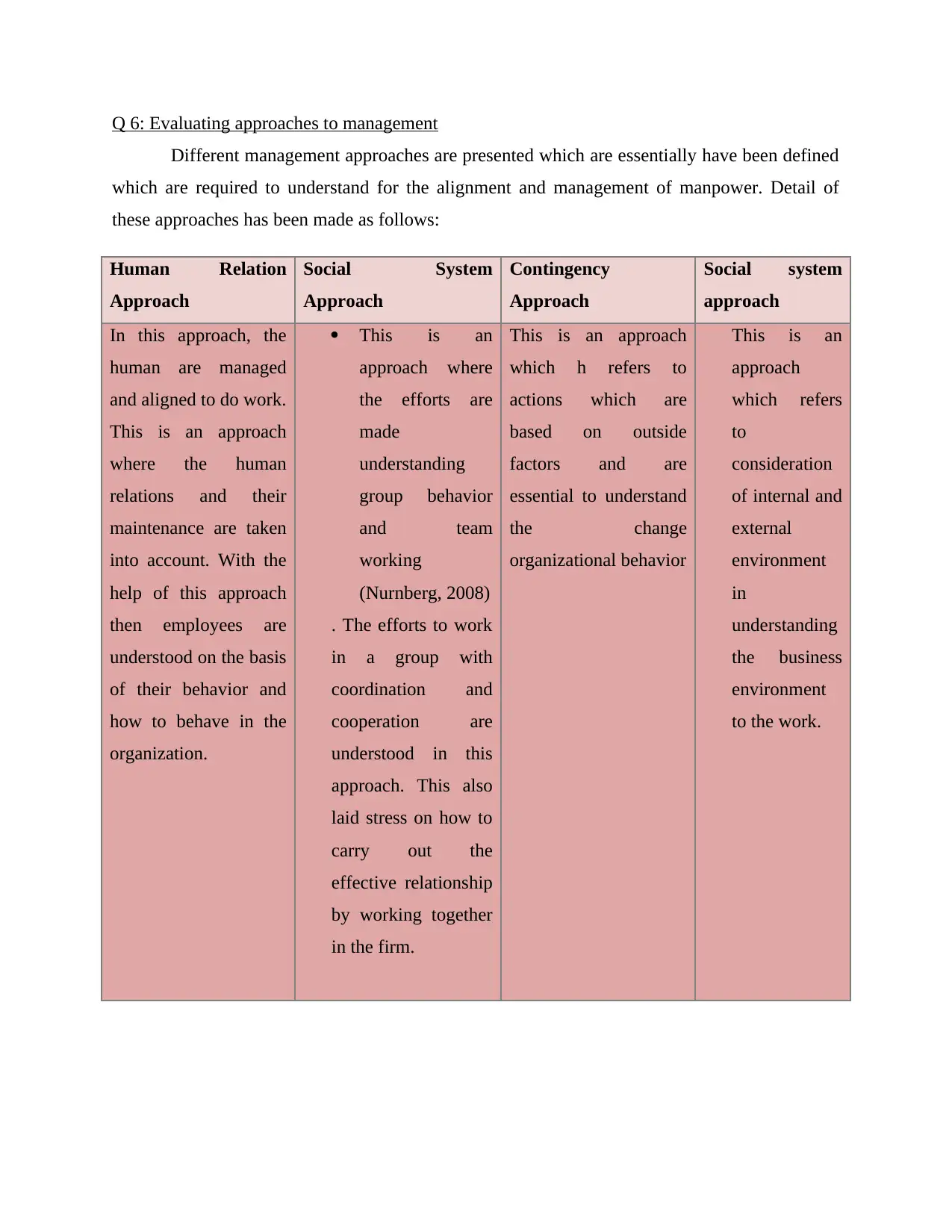
Q 6: Evaluating approaches to management
Different management approaches are presented which are essentially have been defined
which are required to understand for the alignment and management of manpower. Detail of
these approaches has been made as follows:
Human Relation
Approach
Social System
Approach
Contingency
Approach
Social system
approach
In this approach, the
human are managed
and aligned to do work.
This is an approach
where the human
relations and their
maintenance are taken
into account. With the
help of this approach
then employees are
understood on the basis
of their behavior and
how to behave in the
organization.
This is an
approach where
the efforts are
made
understanding
group behavior
and team
working
(Nurnberg, 2008)
. The efforts to work
in a group with
coordination and
cooperation are
understood in this
approach. This also
laid stress on how to
carry out the
effective relationship
by working together
in the firm.
This is an approach
which h refers to
actions which are
based on outside
factors and are
essential to understand
the change
organizational behavior
This is an
approach
which refers
to
consideration
of internal and
external
environment
in
understanding
the business
environment
to the work.
Different management approaches are presented which are essentially have been defined
which are required to understand for the alignment and management of manpower. Detail of
these approaches has been made as follows:
Human Relation
Approach
Social System
Approach
Contingency
Approach
Social system
approach
In this approach, the
human are managed
and aligned to do work.
This is an approach
where the human
relations and their
maintenance are taken
into account. With the
help of this approach
then employees are
understood on the basis
of their behavior and
how to behave in the
organization.
This is an
approach where
the efforts are
made
understanding
group behavior
and team
working
(Nurnberg, 2008)
. The efforts to work
in a group with
coordination and
cooperation are
understood in this
approach. This also
laid stress on how to
carry out the
effective relationship
by working together
in the firm.
This is an approach
which h refers to
actions which are
based on outside
factors and are
essential to understand
the change
organizational behavior
This is an
approach
which refers
to
consideration
of internal and
external
environment
in
understanding
the business
environment
to the work.

Q7: Impact of different leadership styles may have on motivation of managers and staff during
periods of change
Change is inevitable and hence every organization faces this aspect once or twice in the
life of the working. The central idea behind leading others is to make them motivate for moving
in positive and right direction. It is really required for manpower to make them feel motivated.
Therefore, in a nutshell, style of leadership possesses great impact on motivation.
A period of change for B and Q can be when the company has to introduce new
management. In this regard, by following autocratic style of leadership style may led to creation
of grudges and more issues. The employees may feel threatened by the presence of new manager
and hey may not work productively. There are also chances for employee and they may feel not
valued (Van Wart, 2010). Therefore, they may start feeling de-motivation. In the same way, if
there is followed Democratic when new management has been introduced in B and Q them
employees feel highly motivated as they are fully allowed to participate in decisions. They can
come up with innovative ideas which can be applied to generate the better outcome. The effect of
which helps the company to advance in better ways thereby leads to effective productivity. It will
also lead to least possible grudges and less employee turnover.
Q8. Comparing the application of different motivational theories
Different motivational theories are followed at workplace. The central idea behind using
the theories lies in developing the interest of their employees in an organization for doing better
work and enhances productivity. In that case, following motivational theories have been
examined and their application has been stated as follows:
Application of Maslow theory Application of Herzberg theory
According to this theory, there are
various hierarchies of human needs and
desires.
These are essential to be taken care as it
determines the achievement of grass
root needs in performance of the work.
For instance, Maslow theory can be
applied by management of B and Q so
Herzberg proposed the two factor
theory where two aspects namely
hygiene and motivators are defined.
The employees of B and Q are
segregated on the basis of the category
they fall in to decide their desire.
It was found that there are employees
who get motivated with monetary
periods of change
Change is inevitable and hence every organization faces this aspect once or twice in the
life of the working. The central idea behind leading others is to make them motivate for moving
in positive and right direction. It is really required for manpower to make them feel motivated.
Therefore, in a nutshell, style of leadership possesses great impact on motivation.
A period of change for B and Q can be when the company has to introduce new
management. In this regard, by following autocratic style of leadership style may led to creation
of grudges and more issues. The employees may feel threatened by the presence of new manager
and hey may not work productively. There are also chances for employee and they may feel not
valued (Van Wart, 2010). Therefore, they may start feeling de-motivation. In the same way, if
there is followed Democratic when new management has been introduced in B and Q them
employees feel highly motivated as they are fully allowed to participate in decisions. They can
come up with innovative ideas which can be applied to generate the better outcome. The effect of
which helps the company to advance in better ways thereby leads to effective productivity. It will
also lead to least possible grudges and less employee turnover.
Q8. Comparing the application of different motivational theories
Different motivational theories are followed at workplace. The central idea behind using
the theories lies in developing the interest of their employees in an organization for doing better
work and enhances productivity. In that case, following motivational theories have been
examined and their application has been stated as follows:
Application of Maslow theory Application of Herzberg theory
According to this theory, there are
various hierarchies of human needs and
desires.
These are essential to be taken care as it
determines the achievement of grass
root needs in performance of the work.
For instance, Maslow theory can be
applied by management of B and Q so
Herzberg proposed the two factor
theory where two aspects namely
hygiene and motivators are defined.
The employees of B and Q are
segregated on the basis of the category
they fall in to decide their desire.
It was found that there are employees
who get motivated with monetary
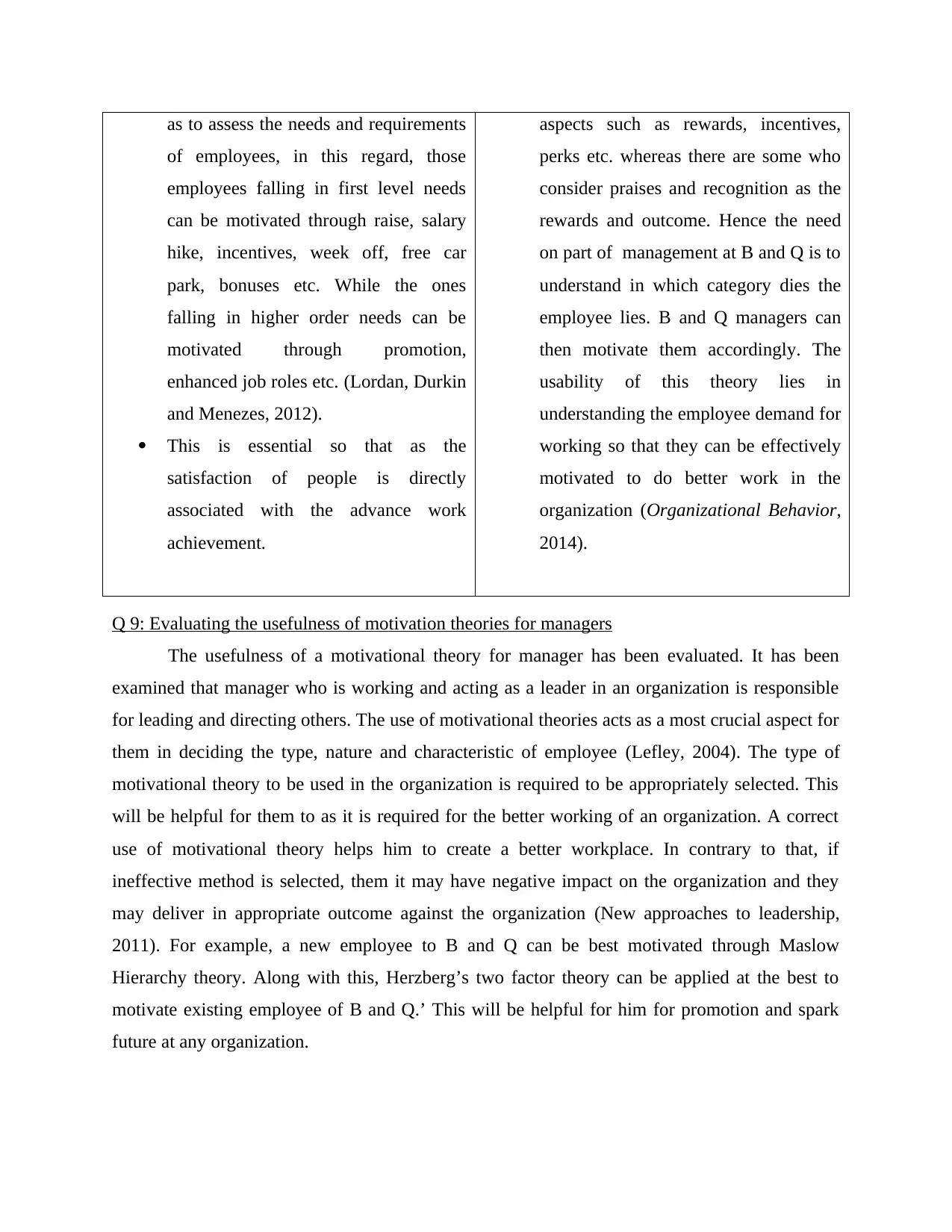
as to assess the needs and requirements
of employees, in this regard, those
employees falling in first level needs
can be motivated through raise, salary
hike, incentives, week off, free car
park, bonuses etc. While the ones
falling in higher order needs can be
motivated through promotion,
enhanced job roles etc. (Lordan, Durkin
and Menezes, 2012).
This is essential so that as the
satisfaction of people is directly
associated with the advance work
achievement.
aspects such as rewards, incentives,
perks etc. whereas there are some who
consider praises and recognition as the
rewards and outcome. Hence the need
on part of management at B and Q is to
understand in which category dies the
employee lies. B and Q managers can
then motivate them accordingly. The
usability of this theory lies in
understanding the employee demand for
working so that they can be effectively
motivated to do better work in the
organization (Organizational Behavior,
2014).
Q 9: Evaluating the usefulness of motivation theories for managers
The usefulness of a motivational theory for manager has been evaluated. It has been
examined that manager who is working and acting as a leader in an organization is responsible
for leading and directing others. The use of motivational theories acts as a most crucial aspect for
them in deciding the type, nature and characteristic of employee (Lefley, 2004). The type of
motivational theory to be used in the organization is required to be appropriately selected. This
will be helpful for them to as it is required for the better working of an organization. A correct
use of motivational theory helps him to create a better workplace. In contrary to that, if
ineffective method is selected, them it may have negative impact on the organization and they
may deliver in appropriate outcome against the organization (New approaches to leadership,
2011). For example, a new employee to B and Q can be best motivated through Maslow
Hierarchy theory. Along with this, Herzberg’s two factor theory can be applied at the best to
motivate existing employee of B and Q.’ This will be helpful for him for promotion and spark
future at any organization.
of employees, in this regard, those
employees falling in first level needs
can be motivated through raise, salary
hike, incentives, week off, free car
park, bonuses etc. While the ones
falling in higher order needs can be
motivated through promotion,
enhanced job roles etc. (Lordan, Durkin
and Menezes, 2012).
This is essential so that as the
satisfaction of people is directly
associated with the advance work
achievement.
aspects such as rewards, incentives,
perks etc. whereas there are some who
consider praises and recognition as the
rewards and outcome. Hence the need
on part of management at B and Q is to
understand in which category dies the
employee lies. B and Q managers can
then motivate them accordingly. The
usability of this theory lies in
understanding the employee demand for
working so that they can be effectively
motivated to do better work in the
organization (Organizational Behavior,
2014).
Q 9: Evaluating the usefulness of motivation theories for managers
The usefulness of a motivational theory for manager has been evaluated. It has been
examined that manager who is working and acting as a leader in an organization is responsible
for leading and directing others. The use of motivational theories acts as a most crucial aspect for
them in deciding the type, nature and characteristic of employee (Lefley, 2004). The type of
motivational theory to be used in the organization is required to be appropriately selected. This
will be helpful for them to as it is required for the better working of an organization. A correct
use of motivational theory helps him to create a better workplace. In contrary to that, if
ineffective method is selected, them it may have negative impact on the organization and they
may deliver in appropriate outcome against the organization (New approaches to leadership,
2011). For example, a new employee to B and Q can be best motivated through Maslow
Hierarchy theory. Along with this, Herzberg’s two factor theory can be applied at the best to
motivate existing employee of B and Q.’ This will be helpful for him for promotion and spark
future at any organization.
Secure Best Marks with AI Grader
Need help grading? Try our AI Grader for instant feedback on your assignments.
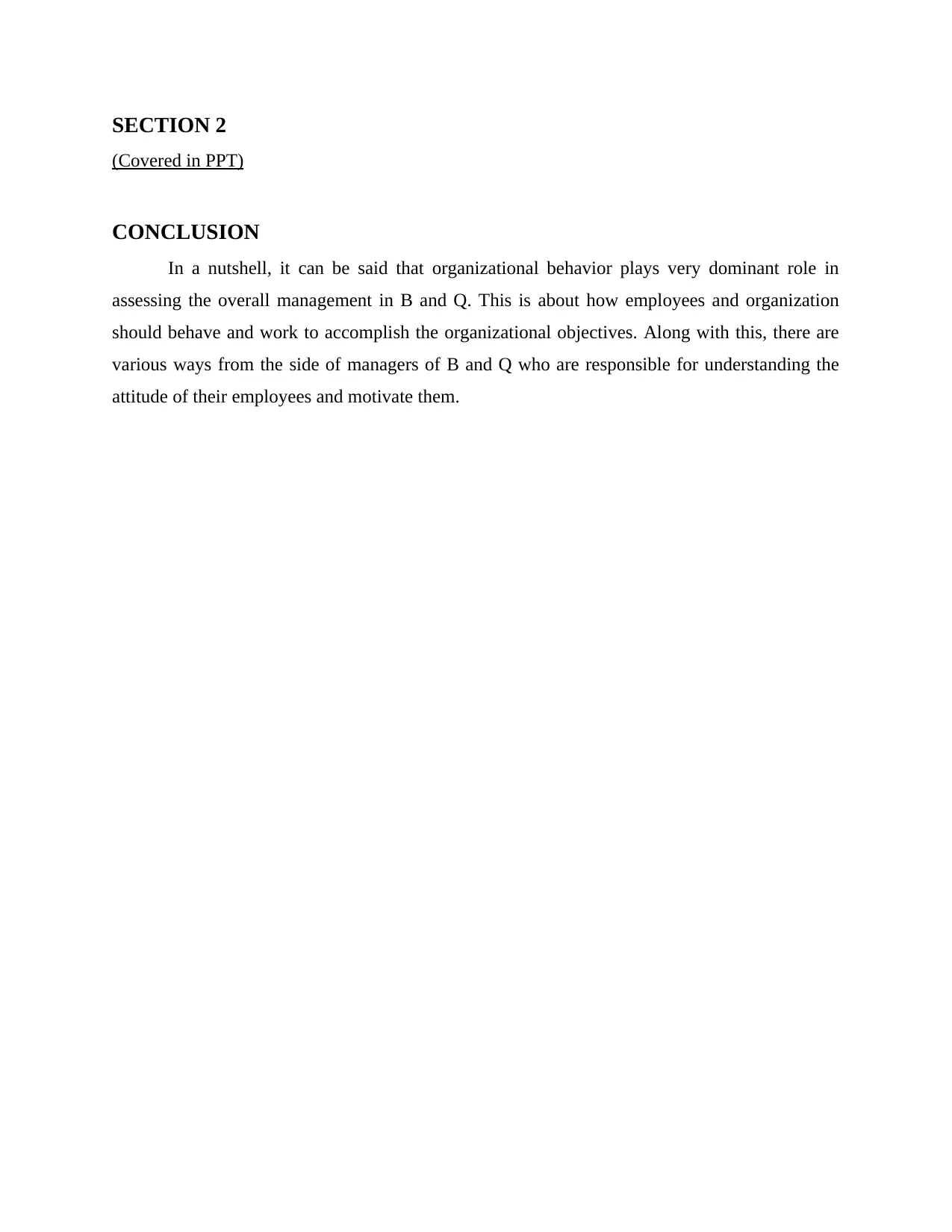
SECTION 2
(Covered in PPT)
CONCLUSION
In a nutshell, it can be said that organizational behavior plays very dominant role in
assessing the overall management in B and Q. This is about how employees and organization
should behave and work to accomplish the organizational objectives. Along with this, there are
various ways from the side of managers of B and Q who are responsible for understanding the
attitude of their employees and motivate them.
(Covered in PPT)
CONCLUSION
In a nutshell, it can be said that organizational behavior plays very dominant role in
assessing the overall management in B and Q. This is about how employees and organization
should behave and work to accomplish the organizational objectives. Along with this, there are
various ways from the side of managers of B and Q who are responsible for understanding the
attitude of their employees and motivate them.
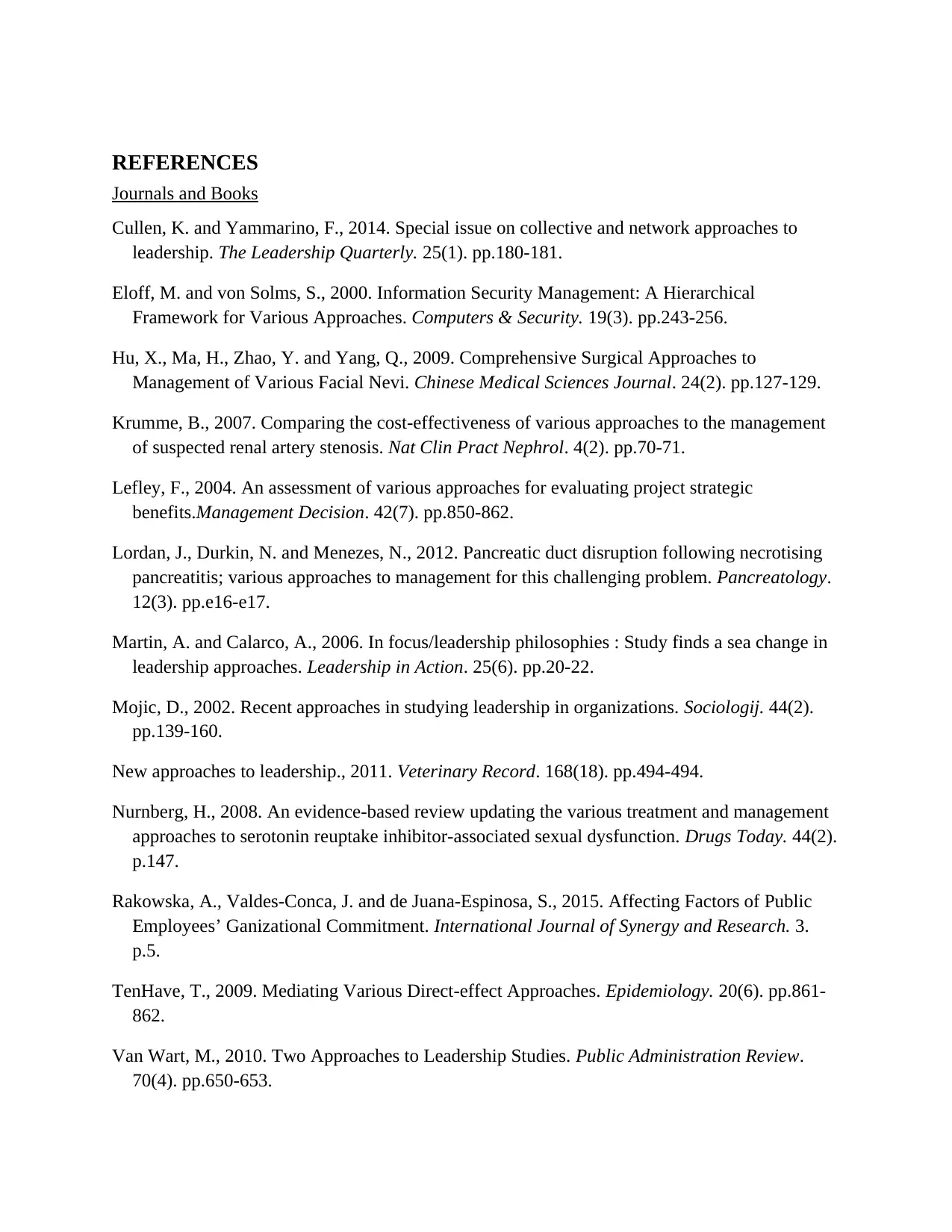
REFERENCES
Journals and Books
Cullen, K. and Yammarino, F., 2014. Special issue on collective and network approaches to
leadership. The Leadership Quarterly. 25(1). pp.180-181.
Eloff, M. and von Solms, S., 2000. Information Security Management: A Hierarchical
Framework for Various Approaches. Computers & Security. 19(3). pp.243-256.
Hu, X., Ma, H., Zhao, Y. and Yang, Q., 2009. Comprehensive Surgical Approaches to
Management of Various Facial Nevi. Chinese Medical Sciences Journal. 24(2). pp.127-129.
Krumme, B., 2007. Comparing the cost-effectiveness of various approaches to the management
of suspected renal artery stenosis. Nat Clin Pract Nephrol. 4(2). pp.70-71.
Lefley, F., 2004. An assessment of various approaches for evaluating project strategic
benefits.Management Decision. 42(7). pp.850-862.
Lordan, J., Durkin, N. and Menezes, N., 2012. Pancreatic duct disruption following necrotising
pancreatitis; various approaches to management for this challenging problem. Pancreatology.
12(3). pp.e16-e17.
Martin, A. and Calarco, A., 2006. In focus/leadership philosophies : Study finds a sea change in
leadership approaches. Leadership in Action. 25(6). pp.20-22.
Mojic, D., 2002. Recent approaches in studying leadership in organizations. Sociologij. 44(2).
pp.139-160.
New approaches to leadership., 2011. Veterinary Record. 168(18). pp.494-494.
Nurnberg, H., 2008. An evidence-based review updating the various treatment and management
approaches to serotonin reuptake inhibitor-associated sexual dysfunction. Drugs Today. 44(2).
p.147.
Rakowska, A., Valdes-Conca, J. and de Juana-Espinosa, S., 2015. Affecting Factors of Public
Employees’ Ganizational Commitment. International Journal of Synergy and Research. 3.
p.5.
TenHave, T., 2009. Mediating Various Direct-effect Approaches. Epidemiology. 20(6). pp.861-
862.
Van Wart, M., 2010. Two Approaches to Leadership Studies. Public Administration Review.
70(4). pp.650-653.
Journals and Books
Cullen, K. and Yammarino, F., 2014. Special issue on collective and network approaches to
leadership. The Leadership Quarterly. 25(1). pp.180-181.
Eloff, M. and von Solms, S., 2000. Information Security Management: A Hierarchical
Framework for Various Approaches. Computers & Security. 19(3). pp.243-256.
Hu, X., Ma, H., Zhao, Y. and Yang, Q., 2009. Comprehensive Surgical Approaches to
Management of Various Facial Nevi. Chinese Medical Sciences Journal. 24(2). pp.127-129.
Krumme, B., 2007. Comparing the cost-effectiveness of various approaches to the management
of suspected renal artery stenosis. Nat Clin Pract Nephrol. 4(2). pp.70-71.
Lefley, F., 2004. An assessment of various approaches for evaluating project strategic
benefits.Management Decision. 42(7). pp.850-862.
Lordan, J., Durkin, N. and Menezes, N., 2012. Pancreatic duct disruption following necrotising
pancreatitis; various approaches to management for this challenging problem. Pancreatology.
12(3). pp.e16-e17.
Martin, A. and Calarco, A., 2006. In focus/leadership philosophies : Study finds a sea change in
leadership approaches. Leadership in Action. 25(6). pp.20-22.
Mojic, D., 2002. Recent approaches in studying leadership in organizations. Sociologij. 44(2).
pp.139-160.
New approaches to leadership., 2011. Veterinary Record. 168(18). pp.494-494.
Nurnberg, H., 2008. An evidence-based review updating the various treatment and management
approaches to serotonin reuptake inhibitor-associated sexual dysfunction. Drugs Today. 44(2).
p.147.
Rakowska, A., Valdes-Conca, J. and de Juana-Espinosa, S., 2015. Affecting Factors of Public
Employees’ Ganizational Commitment. International Journal of Synergy and Research. 3.
p.5.
TenHave, T., 2009. Mediating Various Direct-effect Approaches. Epidemiology. 20(6). pp.861-
862.
Van Wart, M., 2010. Two Approaches to Leadership Studies. Public Administration Review.
70(4). pp.650-653.
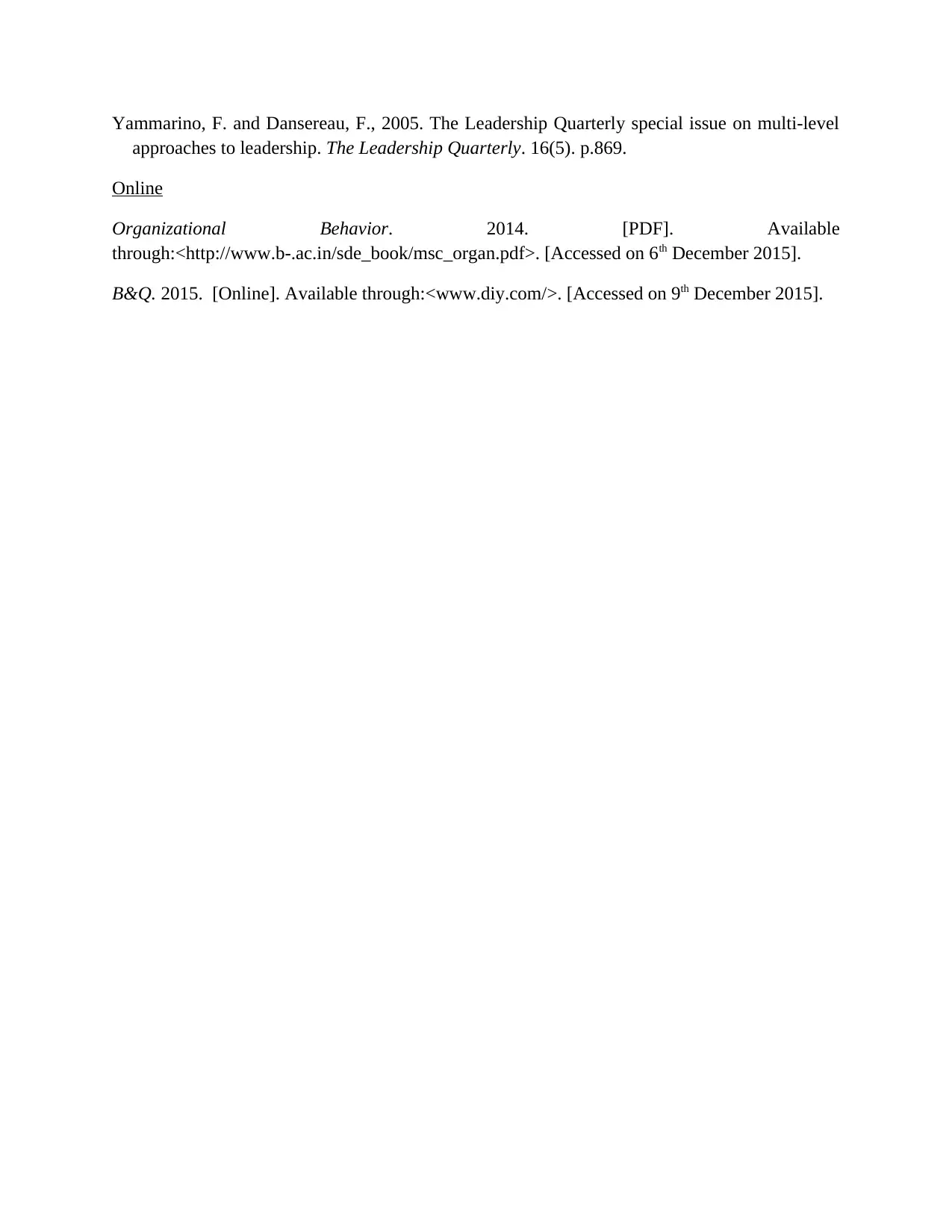
Yammarino, F. and Dansereau, F., 2005. The Leadership Quarterly special issue on multi-level
approaches to leadership. The Leadership Quarterly. 16(5). p.869.
Online
Organizational Behavior. 2014. [PDF]. Available
through:<http://www.b-.ac.in/sde_book/msc_organ.pdf>. [Accessed on 6th December 2015].
B&Q. 2015. [Online]. Available through:<www.diy.com/>. [Accessed on 9th December 2015].
approaches to leadership. The Leadership Quarterly. 16(5). p.869.
Online
Organizational Behavior. 2014. [PDF]. Available
through:<http://www.b-.ac.in/sde_book/msc_organ.pdf>. [Accessed on 6th December 2015].
B&Q. 2015. [Online]. Available through:<www.diy.com/>. [Accessed on 9th December 2015].
1 out of 13
Related Documents
Your All-in-One AI-Powered Toolkit for Academic Success.
+13062052269
info@desklib.com
Available 24*7 on WhatsApp / Email
![[object Object]](/_next/static/media/star-bottom.7253800d.svg)
Unlock your academic potential
© 2024 | Zucol Services PVT LTD | All rights reserved.





